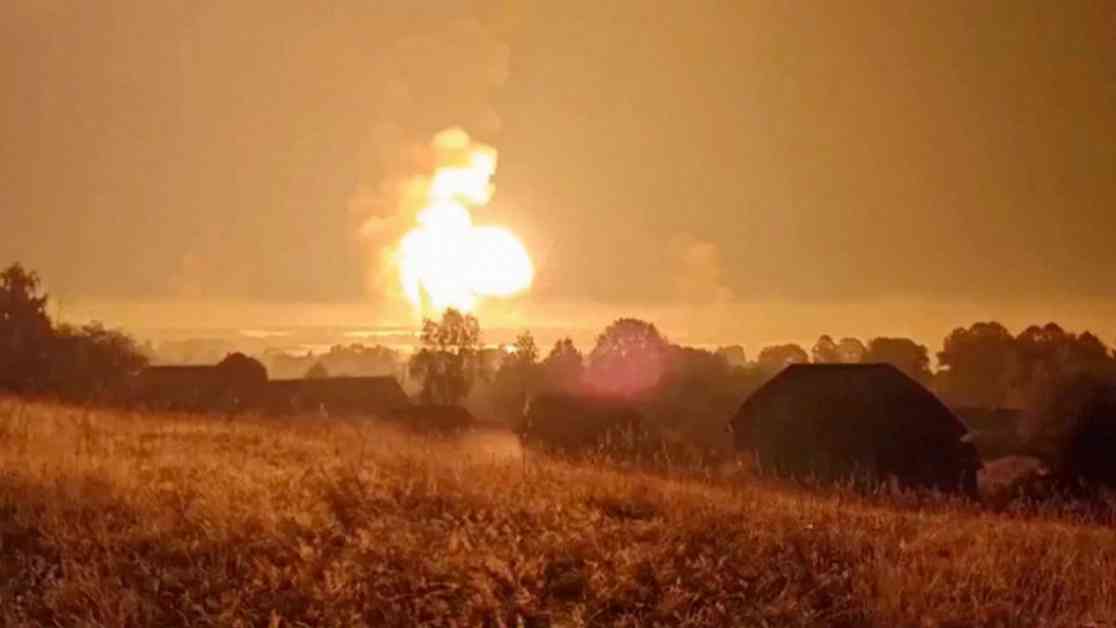A mass drone attack launched by Ukraine has resulted in a massive explosion and the triggering of an earthquake at a Russian weapons arsenal in Toropets, Tver region, north-west of Moscow. The attack targeted a large warehouse belonging to the Main Missile and Artillery Directorate of the Russian Ministry of Defence, containing missiles for Iskander and Tochka-U tactical missile systems, guided aerial bombs, and artillery ammunition.
The Ukrainian security source reported that the attack caused an “extremely powerful detonation,” leading to a significant fire that spanned an area 6km wide. Satellite images from NASA showed intense heat sources emanating from a five-square-mile area, while earthquake monitoring stations detected what sensors identified as a small earthquake.
Following the attack, the governor of the region, Igor Rudenya, stated that emergency services were working to contain the blaze ignited by the drone strike. He also mentioned that Ukrainian drones had been shot down during the operation, resulting in the evacuation of some residents from the area. Additionally, a partial evacuation of the nearby town of Toropets, with a population of around 13,000 people, was ordered due to safety concerns.
In the aftermath of the incident, reports indicated that Russian state media announced the closure of regional schools and nurseries in Toropets. Residents of the town took to a local chatroom on the Russian social media site VK to check on each other and share information. One woman expressed her distress over the destruction of her village, while another described the situation as “horror.”
The significance of the Russian arms depot targeted in the drone strike cannot be understated. Located near Toropets, the arsenal housed a vast array of conventional weapons, including fuel tanks, artillery shells, ballistic missiles, and explosives. These weapons were reportedly used in Russia’s incursion into Ukraine, making the site a crucial military asset for the Russian forces.
According to Dmitry Bulgakov, a former deputy defence minister, each storage facility at the arsenal could hold up to 240 tonnes of weaponry, with provisions for accommodating 200 servicemen. The construction of the arsenal in 2015, at a cost of 3.6 billion roubles, was completed in 2018. Andriy Kovalenko, head of Ukraine’s Centre for countering disinformation, alleged that the site also stored North Korean missiles.
The drone strike on the Russian arms depot in Toropets signifies a significant escalation in the conflict between Ukraine and Russia. As tensions continue to rise, the repercussions of this attack are likely to reverberate throughout the region and beyond.
Analysis of the Drone Attack
The coordinated drone attack by Ukraine on the Russian weapons arsenal in Toropets represents a new chapter in the ongoing conflict between the two nations. The use of drones to target a crucial military facility demonstrates the evolving tactics employed by Ukrainian forces in their resistance against Russian aggression.
The successful execution of the drone strike indicates a level of sophistication and planning on the part of the Ukrainian military. By targeting the main missile and artillery warehouse of the Russian Ministry of Defence, Ukraine aimed to disrupt Russia’s military capabilities and undermine its strategic advantage in the region.
The destruction caused by the attack, including the massive explosion and subsequent fire, highlights the devastating impact of modern warfare tactics. The use of drones to deliver precision strikes on high-value targets has become increasingly common in conflicts around the world, showcasing the evolving nature of warfare in the 21st century.
International Implications
The drone attack on the Russian arms depot in Toropets is likely to have far-reaching international implications. As the conflict between Ukraine and Russia intensifies, other countries and international organizations may be compelled to take a stance on the escalating violence in the region.
The use of drones in combat raises questions about the regulation and control of unmanned aerial vehicles in warfare. The ability of drones to deliver targeted strikes with precision and accuracy poses a challenge to traditional military tactics and strategies, leading to a reevaluation of conventional warfare practices.
Furthermore, the involvement of NATO-supplied drones in the attack on the Russian arsenal raises concerns about the potential for further escalation of the conflict. The use of advanced military technology by Ukrainian forces underscores the support they receive from international allies, highlighting the complex web of alliances and rivalries at play in the region.
Humanitarian Concerns
Amidst the destruction caused by the drone attack in Toropets, humanitarian concerns have come to the forefront. The evacuation of residents from the area, as well as the closure of schools and nurseries, underscores the impact of armed conflict on civilian populations.
The displacement of thousands of people due to the attack raises questions about the safety and well-being of those affected by the violence. The psychological and emotional toll of living in a conflict zone, coupled with the physical dangers posed by military strikes, highlights the urgent need for humanitarian assistance and support.
As the conflict in Ukraine continues to escalate, the international community must prioritize the protection of civilians and the provision of essential services to those impacted by the violence. Humanitarian organizations play a vital role in responding to crises and mitigating the suffering of vulnerable populations affected by armed conflict.
In conclusion, the drone attack on the Russian arms depot in Toropets represents a significant development in the conflict between Ukraine and Russia. The use of advanced military technology, including drones, underscores the evolving nature of modern warfare and the challenges it poses for traditional military strategies. As the situation continues to unfold, it is essential for the international community to prioritize the protection of civilians and work towards a peaceful resolution to the conflict.













